HA3011 Advanced Financial Accounting: Analysis of Reporting
VerifiedAdded on 2023/06/11
|8
|2306
|82
Report
AI Summary
This report provides an in-depth analysis of financial reporting, emphasizing its qualitative features and the impact of various regulatory frameworks. It examines the implications of IFRS adoption, contrasting it with US GAAP, particularly concerning fair value methods and asset revaluation. The report also delves into the perspectives of company directors regarding the adoption of revaluation models and the potential effects on shareholder wealth. Through a detailed discussion of relevant theories and practical examples, the report offers recommendations for regulatory bodies and companies, highlighting the importance of transparent and reliable financial reporting for stakeholders. Desklib provides access to this and other solved assignments to aid students in their studies.
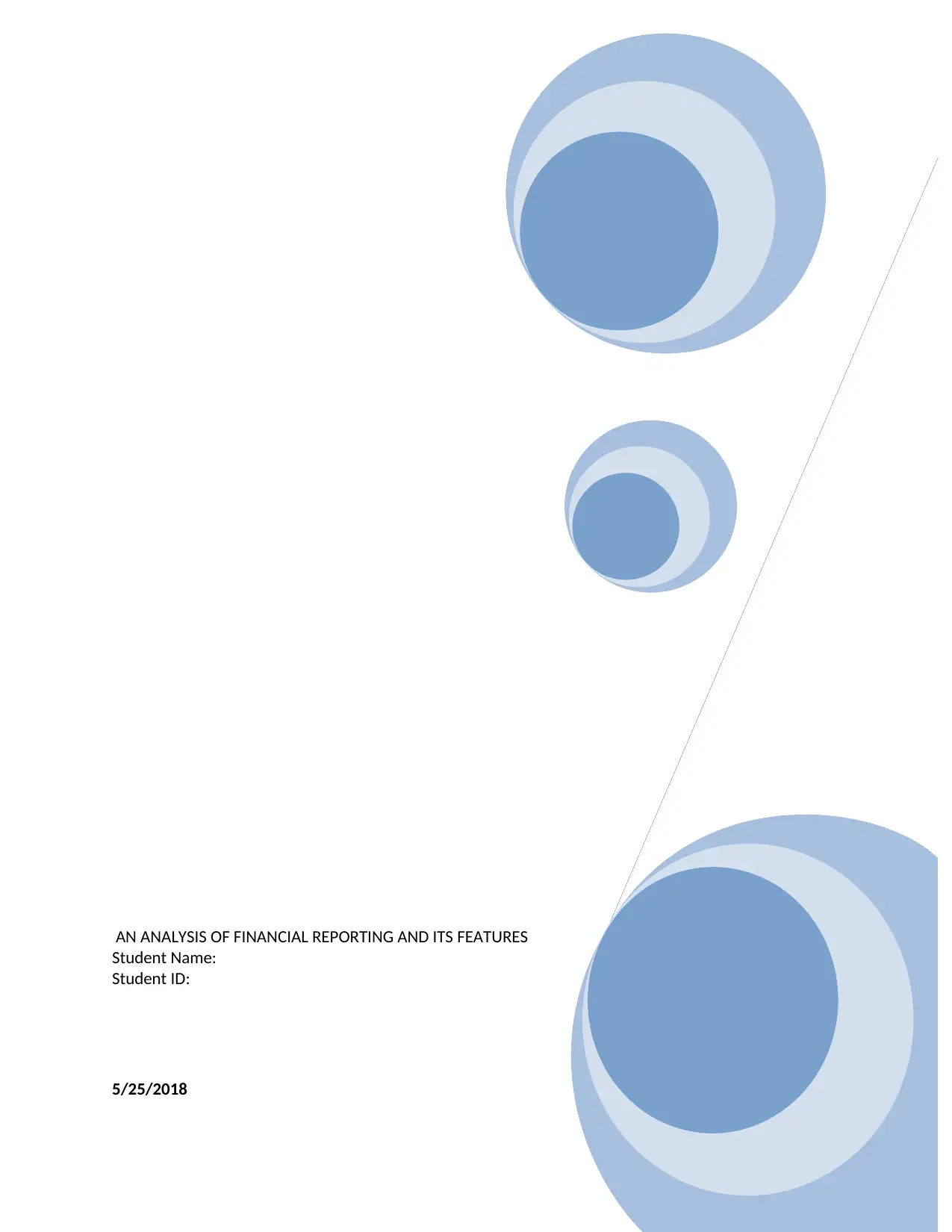
AN ANALYSIS OF FINANCIAL REPORTING AND ITS FEATURES
Student Name:
Student ID:
5/25/2018
Student Name:
Student ID:
5/25/2018
Paraphrase This Document
Need a fresh take? Get an instant paraphrase of this document with our AI Paraphraser
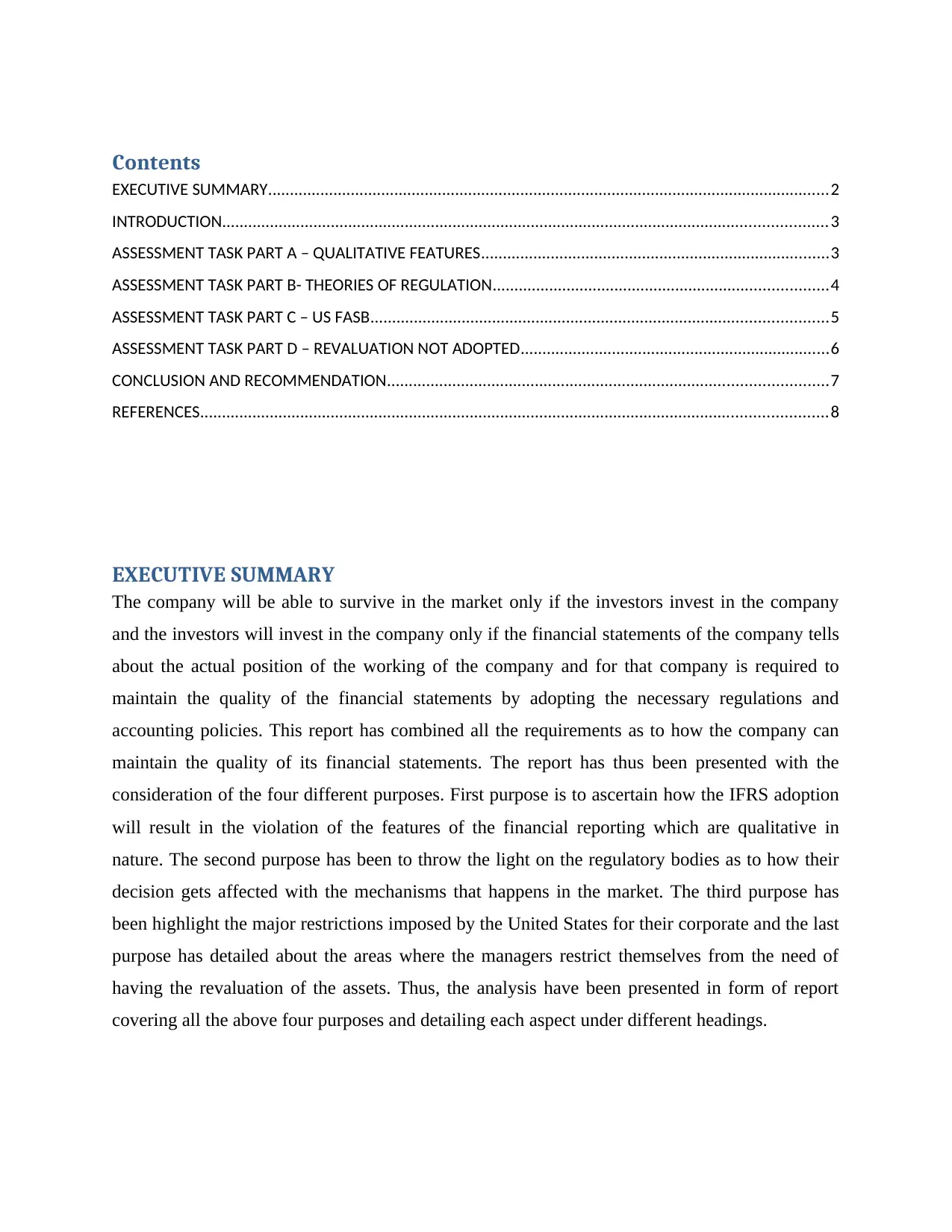
Contents
EXECUTIVE SUMMARY.................................................................................................................................2
INTRODUCTION...........................................................................................................................................3
ASSESSMENT TASK PART A – QUALITATIVE FEATURES................................................................................3
ASSESSMENT TASK PART B- THEORIES OF REGULATION.............................................................................4
ASSESSMENT TASK PART C – US FASB.........................................................................................................5
ASSESSMENT TASK PART D – REVALUATION NOT ADOPTED.......................................................................6
CONCLUSION AND RECOMMENDATION.....................................................................................................7
REFERENCES................................................................................................................................................8
EXECUTIVE SUMMARY
The company will be able to survive in the market only if the investors invest in the company
and the investors will invest in the company only if the financial statements of the company tells
about the actual position of the working of the company and for that company is required to
maintain the quality of the financial statements by adopting the necessary regulations and
accounting policies. This report has combined all the requirements as to how the company can
maintain the quality of its financial statements. The report has thus been presented with the
consideration of the four different purposes. First purpose is to ascertain how the IFRS adoption
will result in the violation of the features of the financial reporting which are qualitative in
nature. The second purpose has been to throw the light on the regulatory bodies as to how their
decision gets affected with the mechanisms that happens in the market. The third purpose has
been highlight the major restrictions imposed by the United States for their corporate and the last
purpose has detailed about the areas where the managers restrict themselves from the need of
having the revaluation of the assets. Thus, the analysis have been presented in form of report
covering all the above four purposes and detailing each aspect under different headings.
EXECUTIVE SUMMARY.................................................................................................................................2
INTRODUCTION...........................................................................................................................................3
ASSESSMENT TASK PART A – QUALITATIVE FEATURES................................................................................3
ASSESSMENT TASK PART B- THEORIES OF REGULATION.............................................................................4
ASSESSMENT TASK PART C – US FASB.........................................................................................................5
ASSESSMENT TASK PART D – REVALUATION NOT ADOPTED.......................................................................6
CONCLUSION AND RECOMMENDATION.....................................................................................................7
REFERENCES................................................................................................................................................8
EXECUTIVE SUMMARY
The company will be able to survive in the market only if the investors invest in the company
and the investors will invest in the company only if the financial statements of the company tells
about the actual position of the working of the company and for that company is required to
maintain the quality of the financial statements by adopting the necessary regulations and
accounting policies. This report has combined all the requirements as to how the company can
maintain the quality of its financial statements. The report has thus been presented with the
consideration of the four different purposes. First purpose is to ascertain how the IFRS adoption
will result in the violation of the features of the financial reporting which are qualitative in
nature. The second purpose has been to throw the light on the regulatory bodies as to how their
decision gets affected with the mechanisms that happens in the market. The third purpose has
been highlight the major restrictions imposed by the United States for their corporate and the last
purpose has detailed about the areas where the managers restrict themselves from the need of
having the revaluation of the assets. Thus, the analysis have been presented in form of report
covering all the above four purposes and detailing each aspect under different headings.
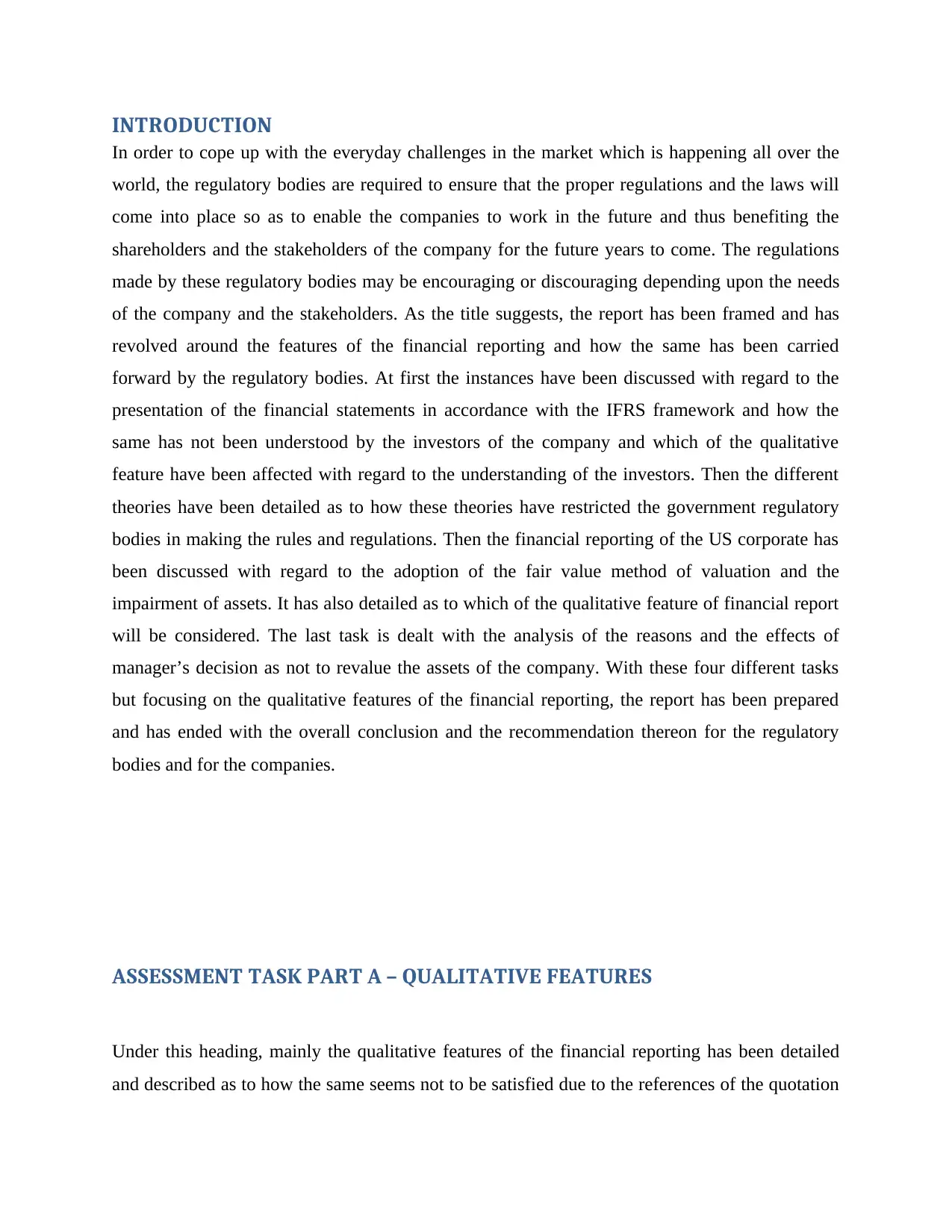
INTRODUCTION
In order to cope up with the everyday challenges in the market which is happening all over the
world, the regulatory bodies are required to ensure that the proper regulations and the laws will
come into place so as to enable the companies to work in the future and thus benefiting the
shareholders and the stakeholders of the company for the future years to come. The regulations
made by these regulatory bodies may be encouraging or discouraging depending upon the needs
of the company and the stakeholders. As the title suggests, the report has been framed and has
revolved around the features of the financial reporting and how the same has been carried
forward by the regulatory bodies. At first the instances have been discussed with regard to the
presentation of the financial statements in accordance with the IFRS framework and how the
same has not been understood by the investors of the company and which of the qualitative
feature have been affected with regard to the understanding of the investors. Then the different
theories have been detailed as to how these theories have restricted the government regulatory
bodies in making the rules and regulations. Then the financial reporting of the US corporate has
been discussed with regard to the adoption of the fair value method of valuation and the
impairment of assets. It has also detailed as to which of the qualitative feature of financial report
will be considered. The last task is dealt with the analysis of the reasons and the effects of
manager’s decision as not to revalue the assets of the company. With these four different tasks
but focusing on the qualitative features of the financial reporting, the report has been prepared
and has ended with the overall conclusion and the recommendation thereon for the regulatory
bodies and for the companies.
ASSESSMENT TASK PART A – QUALITATIVE FEATURES
Under this heading, mainly the qualitative features of the financial reporting has been detailed
and described as to how the same seems not to be satisfied due to the references of the quotation
In order to cope up with the everyday challenges in the market which is happening all over the
world, the regulatory bodies are required to ensure that the proper regulations and the laws will
come into place so as to enable the companies to work in the future and thus benefiting the
shareholders and the stakeholders of the company for the future years to come. The regulations
made by these regulatory bodies may be encouraging or discouraging depending upon the needs
of the company and the stakeholders. As the title suggests, the report has been framed and has
revolved around the features of the financial reporting and how the same has been carried
forward by the regulatory bodies. At first the instances have been discussed with regard to the
presentation of the financial statements in accordance with the IFRS framework and how the
same has not been understood by the investors of the company and which of the qualitative
feature have been affected with regard to the understanding of the investors. Then the different
theories have been detailed as to how these theories have restricted the government regulatory
bodies in making the rules and regulations. Then the financial reporting of the US corporate has
been discussed with regard to the adoption of the fair value method of valuation and the
impairment of assets. It has also detailed as to which of the qualitative feature of financial report
will be considered. The last task is dealt with the analysis of the reasons and the effects of
manager’s decision as not to revalue the assets of the company. With these four different tasks
but focusing on the qualitative features of the financial reporting, the report has been prepared
and has ended with the overall conclusion and the recommendation thereon for the regulatory
bodies and for the companies.
ASSESSMENT TASK PART A – QUALITATIVE FEATURES
Under this heading, mainly the qualitative features of the financial reporting has been detailed
and described as to how the same seems not to be satisfied due to the references of the quotation
⊘ This is a preview!⊘
Do you want full access?
Subscribe today to unlock all pages.

Trusted by 1+ million students worldwide
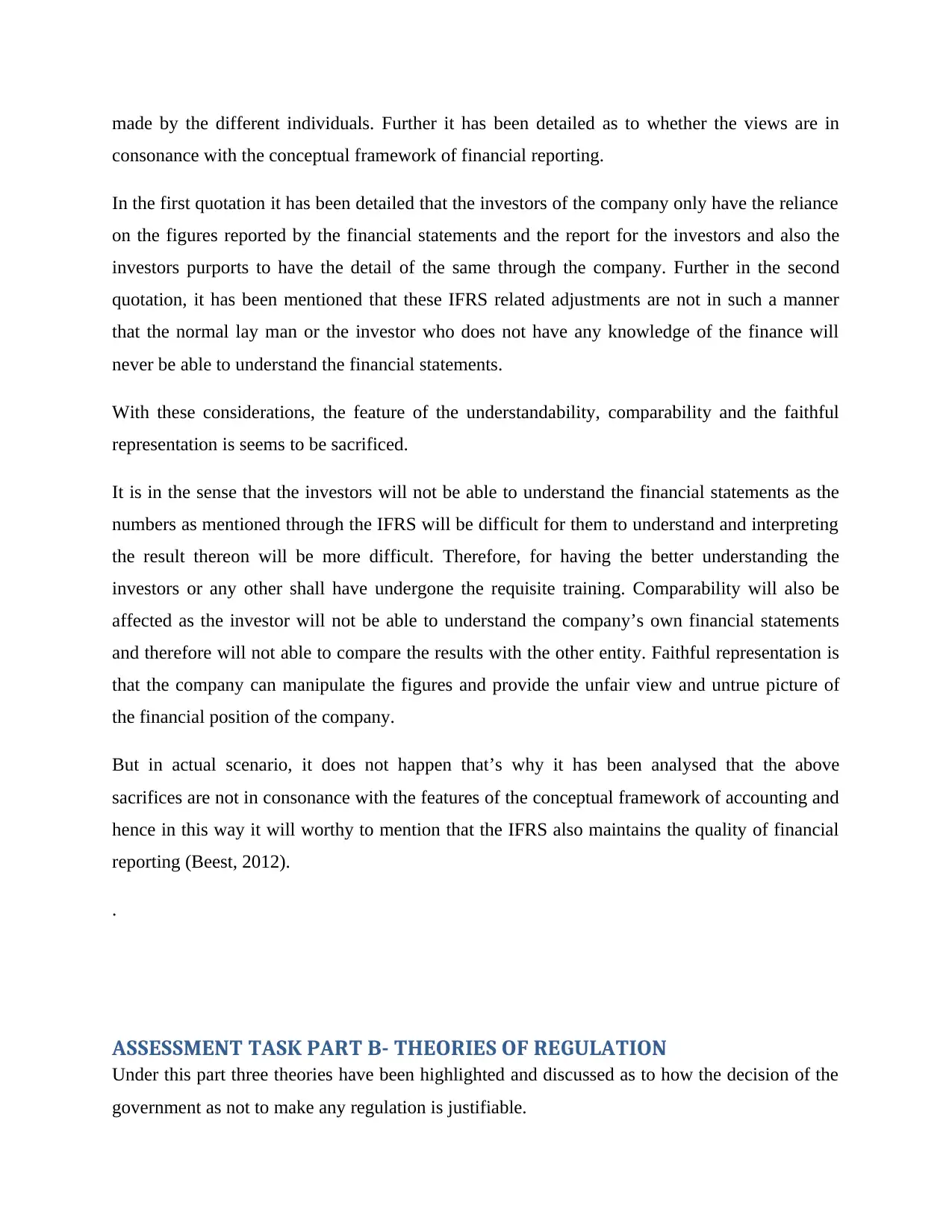
made by the different individuals. Further it has been detailed as to whether the views are in
consonance with the conceptual framework of financial reporting.
In the first quotation it has been detailed that the investors of the company only have the reliance
on the figures reported by the financial statements and the report for the investors and also the
investors purports to have the detail of the same through the company. Further in the second
quotation, it has been mentioned that these IFRS related adjustments are not in such a manner
that the normal lay man or the investor who does not have any knowledge of the finance will
never be able to understand the financial statements.
With these considerations, the feature of the understandability, comparability and the faithful
representation is seems to be sacrificed.
It is in the sense that the investors will not be able to understand the financial statements as the
numbers as mentioned through the IFRS will be difficult for them to understand and interpreting
the result thereon will be more difficult. Therefore, for having the better understanding the
investors or any other shall have undergone the requisite training. Comparability will also be
affected as the investor will not be able to understand the company’s own financial statements
and therefore will not able to compare the results with the other entity. Faithful representation is
that the company can manipulate the figures and provide the unfair view and untrue picture of
the financial position of the company.
But in actual scenario, it does not happen that’s why it has been analysed that the above
sacrifices are not in consonance with the features of the conceptual framework of accounting and
hence in this way it will worthy to mention that the IFRS also maintains the quality of financial
reporting (Beest, 2012).
.
ASSESSMENT TASK PART B- THEORIES OF REGULATION
Under this part three theories have been highlighted and discussed as to how the decision of the
government as not to make any regulation is justifiable.
consonance with the conceptual framework of financial reporting.
In the first quotation it has been detailed that the investors of the company only have the reliance
on the figures reported by the financial statements and the report for the investors and also the
investors purports to have the detail of the same through the company. Further in the second
quotation, it has been mentioned that these IFRS related adjustments are not in such a manner
that the normal lay man or the investor who does not have any knowledge of the finance will
never be able to understand the financial statements.
With these considerations, the feature of the understandability, comparability and the faithful
representation is seems to be sacrificed.
It is in the sense that the investors will not be able to understand the financial statements as the
numbers as mentioned through the IFRS will be difficult for them to understand and interpreting
the result thereon will be more difficult. Therefore, for having the better understanding the
investors or any other shall have undergone the requisite training. Comparability will also be
affected as the investor will not be able to understand the company’s own financial statements
and therefore will not able to compare the results with the other entity. Faithful representation is
that the company can manipulate the figures and provide the unfair view and untrue picture of
the financial position of the company.
But in actual scenario, it does not happen that’s why it has been analysed that the above
sacrifices are not in consonance with the features of the conceptual framework of accounting and
hence in this way it will worthy to mention that the IFRS also maintains the quality of financial
reporting (Beest, 2012).
.
ASSESSMENT TASK PART B- THEORIES OF REGULATION
Under this part three theories have been highlighted and discussed as to how the decision of the
government as not to make any regulation is justifiable.
Paraphrase This Document
Need a fresh take? Get an instant paraphrase of this document with our AI Paraphraser
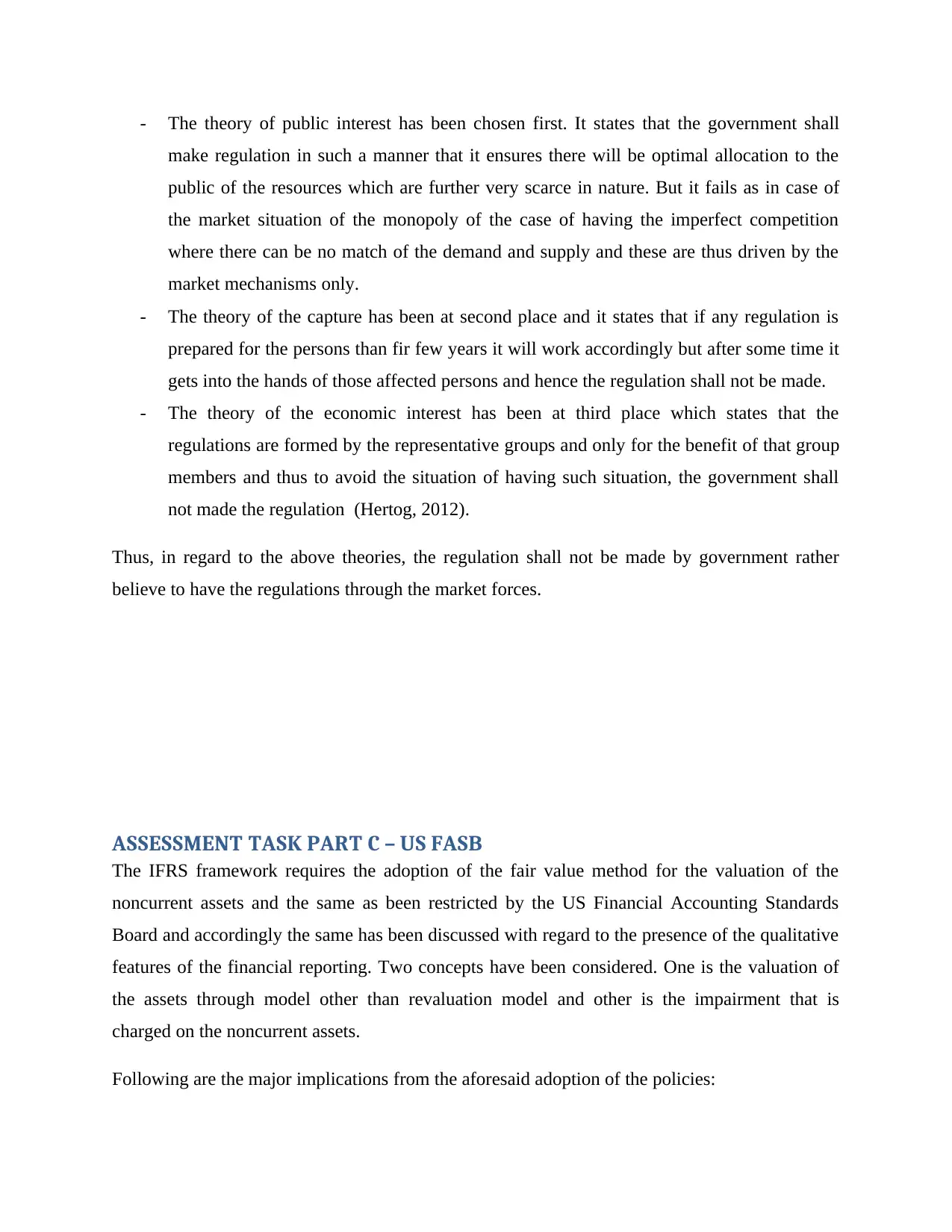
- The theory of public interest has been chosen first. It states that the government shall
make regulation in such a manner that it ensures there will be optimal allocation to the
public of the resources which are further very scarce in nature. But it fails as in case of
the market situation of the monopoly of the case of having the imperfect competition
where there can be no match of the demand and supply and these are thus driven by the
market mechanisms only.
- The theory of the capture has been at second place and it states that if any regulation is
prepared for the persons than fir few years it will work accordingly but after some time it
gets into the hands of those affected persons and hence the regulation shall not be made.
- The theory of the economic interest has been at third place which states that the
regulations are formed by the representative groups and only for the benefit of that group
members and thus to avoid the situation of having such situation, the government shall
not made the regulation (Hertog, 2012).
Thus, in regard to the above theories, the regulation shall not be made by government rather
believe to have the regulations through the market forces.
ASSESSMENT TASK PART C – US FASB
The IFRS framework requires the adoption of the fair value method for the valuation of the
noncurrent assets and the same as been restricted by the US Financial Accounting Standards
Board and accordingly the same has been discussed with regard to the presence of the qualitative
features of the financial reporting. Two concepts have been considered. One is the valuation of
the assets through model other than revaluation model and other is the impairment that is
charged on the noncurrent assets.
Following are the major implications from the aforesaid adoption of the policies:
make regulation in such a manner that it ensures there will be optimal allocation to the
public of the resources which are further very scarce in nature. But it fails as in case of
the market situation of the monopoly of the case of having the imperfect competition
where there can be no match of the demand and supply and these are thus driven by the
market mechanisms only.
- The theory of the capture has been at second place and it states that if any regulation is
prepared for the persons than fir few years it will work accordingly but after some time it
gets into the hands of those affected persons and hence the regulation shall not be made.
- The theory of the economic interest has been at third place which states that the
regulations are formed by the representative groups and only for the benefit of that group
members and thus to avoid the situation of having such situation, the government shall
not made the regulation (Hertog, 2012).
Thus, in regard to the above theories, the regulation shall not be made by government rather
believe to have the regulations through the market forces.
ASSESSMENT TASK PART C – US FASB
The IFRS framework requires the adoption of the fair value method for the valuation of the
noncurrent assets and the same as been restricted by the US Financial Accounting Standards
Board and accordingly the same has been discussed with regard to the presence of the qualitative
features of the financial reporting. Two concepts have been considered. One is the valuation of
the assets through model other than revaluation model and other is the impairment that is
charged on the noncurrent assets.
Following are the major implications from the aforesaid adoption of the policies:
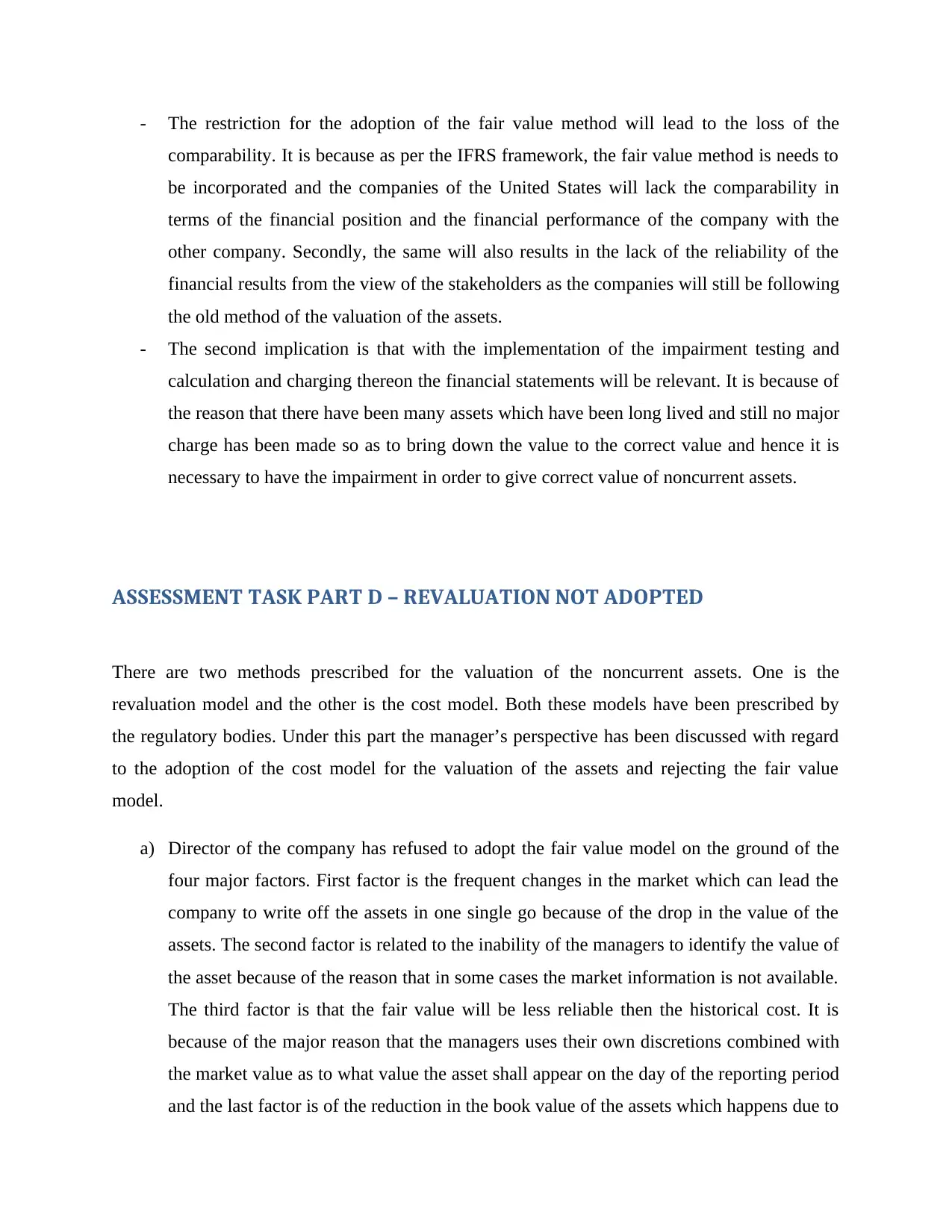
- The restriction for the adoption of the fair value method will lead to the loss of the
comparability. It is because as per the IFRS framework, the fair value method is needs to
be incorporated and the companies of the United States will lack the comparability in
terms of the financial position and the financial performance of the company with the
other company. Secondly, the same will also results in the lack of the reliability of the
financial results from the view of the stakeholders as the companies will still be following
the old method of the valuation of the assets.
- The second implication is that with the implementation of the impairment testing and
calculation and charging thereon the financial statements will be relevant. It is because of
the reason that there have been many assets which have been long lived and still no major
charge has been made so as to bring down the value to the correct value and hence it is
necessary to have the impairment in order to give correct value of noncurrent assets.
ASSESSMENT TASK PART D – REVALUATION NOT ADOPTED
There are two methods prescribed for the valuation of the noncurrent assets. One is the
revaluation model and the other is the cost model. Both these models have been prescribed by
the regulatory bodies. Under this part the manager’s perspective has been discussed with regard
to the adoption of the cost model for the valuation of the assets and rejecting the fair value
model.
a) Director of the company has refused to adopt the fair value model on the ground of the
four major factors. First factor is the frequent changes in the market which can lead the
company to write off the assets in one single go because of the drop in the value of the
assets. The second factor is related to the inability of the managers to identify the value of
the asset because of the reason that in some cases the market information is not available.
The third factor is that the fair value will be less reliable then the historical cost. It is
because of the major reason that the managers uses their own discretions combined with
the market value as to what value the asset shall appear on the day of the reporting period
and the last factor is of the reduction in the book value of the assets which happens due to
comparability. It is because as per the IFRS framework, the fair value method is needs to
be incorporated and the companies of the United States will lack the comparability in
terms of the financial position and the financial performance of the company with the
other company. Secondly, the same will also results in the lack of the reliability of the
financial results from the view of the stakeholders as the companies will still be following
the old method of the valuation of the assets.
- The second implication is that with the implementation of the impairment testing and
calculation and charging thereon the financial statements will be relevant. It is because of
the reason that there have been many assets which have been long lived and still no major
charge has been made so as to bring down the value to the correct value and hence it is
necessary to have the impairment in order to give correct value of noncurrent assets.
ASSESSMENT TASK PART D – REVALUATION NOT ADOPTED
There are two methods prescribed for the valuation of the noncurrent assets. One is the
revaluation model and the other is the cost model. Both these models have been prescribed by
the regulatory bodies. Under this part the manager’s perspective has been discussed with regard
to the adoption of the cost model for the valuation of the assets and rejecting the fair value
model.
a) Director of the company has refused to adopt the fair value model on the ground of the
four major factors. First factor is the frequent changes in the market which can lead the
company to write off the assets in one single go because of the drop in the value of the
assets. The second factor is related to the inability of the managers to identify the value of
the asset because of the reason that in some cases the market information is not available.
The third factor is that the fair value will be less reliable then the historical cost. It is
because of the major reason that the managers uses their own discretions combined with
the market value as to what value the asset shall appear on the day of the reporting period
and the last factor is of the reduction in the book value of the assets which happens due to
⊘ This is a preview!⊘
Do you want full access?
Subscribe today to unlock all pages.

Trusted by 1+ million students worldwide
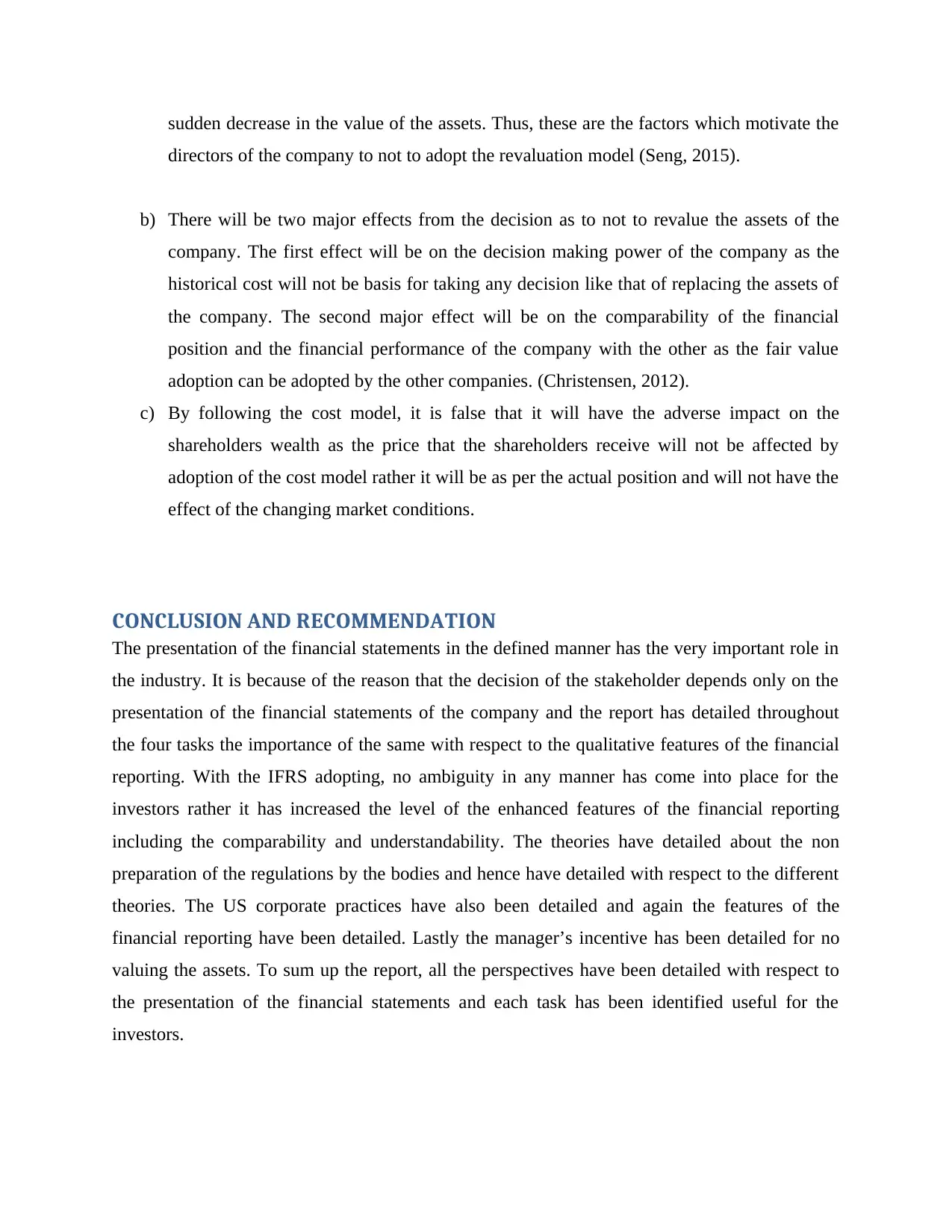
sudden decrease in the value of the assets. Thus, these are the factors which motivate the
directors of the company to not to adopt the revaluation model (Seng, 2015).
b) There will be two major effects from the decision as to not to revalue the assets of the
company. The first effect will be on the decision making power of the company as the
historical cost will not be basis for taking any decision like that of replacing the assets of
the company. The second major effect will be on the comparability of the financial
position and the financial performance of the company with the other as the fair value
adoption can be adopted by the other companies. (Christensen, 2012).
c) By following the cost model, it is false that it will have the adverse impact on the
shareholders wealth as the price that the shareholders receive will not be affected by
adoption of the cost model rather it will be as per the actual position and will not have the
effect of the changing market conditions.
CONCLUSION AND RECOMMENDATION
The presentation of the financial statements in the defined manner has the very important role in
the industry. It is because of the reason that the decision of the stakeholder depends only on the
presentation of the financial statements of the company and the report has detailed throughout
the four tasks the importance of the same with respect to the qualitative features of the financial
reporting. With the IFRS adopting, no ambiguity in any manner has come into place for the
investors rather it has increased the level of the enhanced features of the financial reporting
including the comparability and understandability. The theories have detailed about the non
preparation of the regulations by the bodies and hence have detailed with respect to the different
theories. The US corporate practices have also been detailed and again the features of the
financial reporting have been detailed. Lastly the manager’s incentive has been detailed for no
valuing the assets. To sum up the report, all the perspectives have been detailed with respect to
the presentation of the financial statements and each task has been identified useful for the
investors.
directors of the company to not to adopt the revaluation model (Seng, 2015).
b) There will be two major effects from the decision as to not to revalue the assets of the
company. The first effect will be on the decision making power of the company as the
historical cost will not be basis for taking any decision like that of replacing the assets of
the company. The second major effect will be on the comparability of the financial
position and the financial performance of the company with the other as the fair value
adoption can be adopted by the other companies. (Christensen, 2012).
c) By following the cost model, it is false that it will have the adverse impact on the
shareholders wealth as the price that the shareholders receive will not be affected by
adoption of the cost model rather it will be as per the actual position and will not have the
effect of the changing market conditions.
CONCLUSION AND RECOMMENDATION
The presentation of the financial statements in the defined manner has the very important role in
the industry. It is because of the reason that the decision of the stakeholder depends only on the
presentation of the financial statements of the company and the report has detailed throughout
the four tasks the importance of the same with respect to the qualitative features of the financial
reporting. With the IFRS adopting, no ambiguity in any manner has come into place for the
investors rather it has increased the level of the enhanced features of the financial reporting
including the comparability and understandability. The theories have detailed about the non
preparation of the regulations by the bodies and hence have detailed with respect to the different
theories. The US corporate practices have also been detailed and again the features of the
financial reporting have been detailed. Lastly the manager’s incentive has been detailed for no
valuing the assets. To sum up the report, all the perspectives have been detailed with respect to
the presentation of the financial statements and each task has been identified useful for the
investors.
Paraphrase This Document
Need a fresh take? Get an instant paraphrase of this document with our AI Paraphraser
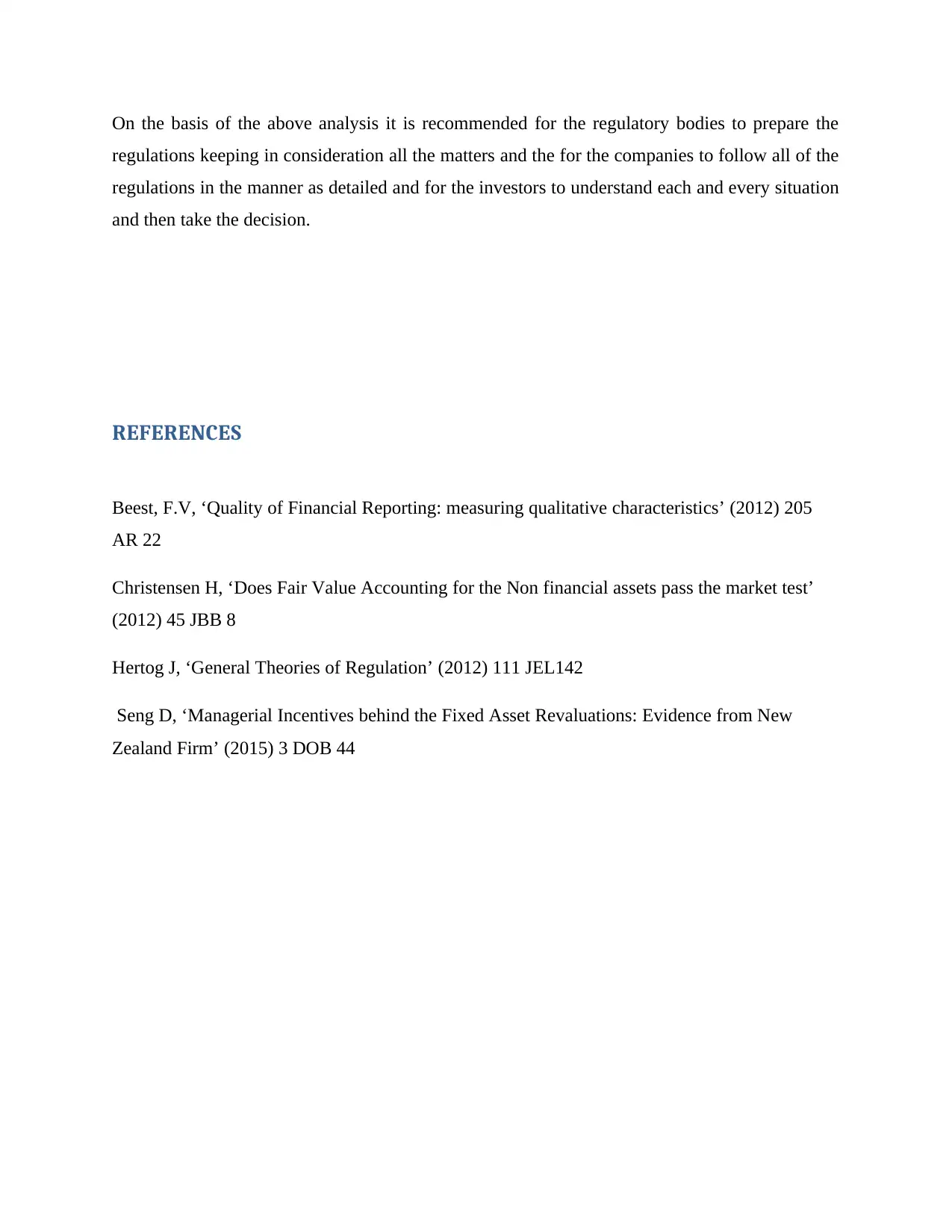
On the basis of the above analysis it is recommended for the regulatory bodies to prepare the
regulations keeping in consideration all the matters and the for the companies to follow all of the
regulations in the manner as detailed and for the investors to understand each and every situation
and then take the decision.
REFERENCES
Beest, F.V, ‘Quality of Financial Reporting: measuring qualitative characteristics’ (2012) 205
AR 22
Christensen H, ‘Does Fair Value Accounting for the Non financial assets pass the market test’
(2012) 45 JBB 8
Hertog J, ‘General Theories of Regulation’ (2012) 111 JEL142
Seng D, ‘Managerial Incentives behind the Fixed Asset Revaluations: Evidence from New
Zealand Firm’ (2015) 3 DOB 44
regulations keeping in consideration all the matters and the for the companies to follow all of the
regulations in the manner as detailed and for the investors to understand each and every situation
and then take the decision.
REFERENCES
Beest, F.V, ‘Quality of Financial Reporting: measuring qualitative characteristics’ (2012) 205
AR 22
Christensen H, ‘Does Fair Value Accounting for the Non financial assets pass the market test’
(2012) 45 JBB 8
Hertog J, ‘General Theories of Regulation’ (2012) 111 JEL142
Seng D, ‘Managerial Incentives behind the Fixed Asset Revaluations: Evidence from New
Zealand Firm’ (2015) 3 DOB 44
1 out of 8
Related Documents
Your All-in-One AI-Powered Toolkit for Academic Success.
+13062052269
info@desklib.com
Available 24*7 on WhatsApp / Email
![[object Object]](/_next/static/media/star-bottom.7253800d.svg)
Unlock your academic potential
Copyright © 2020–2025 A2Z Services. All Rights Reserved. Developed and managed by ZUCOL.





